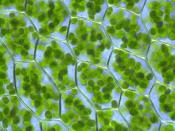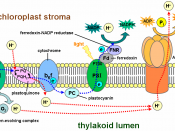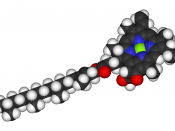PLANT SYSTEMS QUESTION 1979:L. PETERSON/AP BIOLOGY
In relation to plants, describe in detail one way of:
a) measuring the rate of transpiration
b) measuring the rate of photosynthesis
c) separating pigments
Essay :
Transpiration is the loss of water vapor from land plants into the atmosphere, causing movement of water through the plant from the soil to the atmosphere via roots, shoot and leaves, which occurs mainly through the stomata. Factors which can affect the rate of transpiration are those such as temperature, humidity, wind, and light, and the water in the soil. A plant cannot continue to transpire rapidly if its water loss is not made up by replacement from the soil. When absorption of water by the roots fails to keep up with the rate of transpiration, loss of turgor occurs, and the stomata close. This immediately reduces the rate of transpiration (as well as of photosynthesis). If the loss of turgor extends to the rest of the leaf and stem, the plant wilts.
To measure transpiration, you can artificially create the environment for a plant for which you want to transpire. For example, if you have a .1 mL pipette, plastic tubing and a leaf, you have almost all the materials you need to measure the rate of transpiration for that leaf and whatever environmental conditions you impose upon the leaf. One will be examining the amount of water in the tubing which is being used, and from there you can tell how much water has been used.
Photosynthesis is the process by which green plants, algae and some bacteria absorb light energy and use it to synthesize organic compounds. In green plants, photosynthesis occurs in chloroplasts, that contain the photosynthetic pigments. Photosynthesis occurs by slightly different processes in C3 and C4 plants. Factors which can affect...


